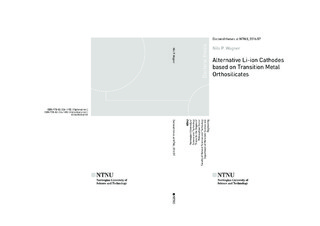| dc.contributor.advisor | Vullum_Bruer, Fride | |
| dc.contributor.advisor | Svensson, Ann Mari | |
| dc.contributor.author | Wagner, Nils P. | |
| dc.date.accessioned | 2016-04-04T10:17:43Z | |
| dc.date.available | 2016-04-04T10:17:43Z | |
| dc.date.issued | 2016 | |
| dc.identifier.isbn | 978-82-326-1453-0 | |
| dc.identifier.issn | 1503-8181 | |
| dc.identifier.uri | http://hdl.handle.net/11250/2383727 | |
| dc.description.abstract | The aspiration of today’s society to become independent from crude oil and nuclear power led to a rapid growth of renewable energy production. Unfortunately, the majority of these energy sources are discontinuous and require energy storage. Alongside this, particularly in Norway, a trend towards electric transportation is observed. Even if details differ, both applications require advanced battery technologies to store energy and facilitate it with a high conversion rate when needed.
Li-ion batteries outperform other battery concepts, but the technology has to be advanced in order to meet the demands of specific applications. In particular, the common positive Li-ion electrode (LiCoO2) has safety and pricing issues to be overcome. Not to mention that it also limits the battery capacity. Both safety and moderate cost are of major importance for the large-scale batteries required in electric vehicles and in stationary energy storage.
This study concerns an alternative positive electrode material class, namely the lithium transition metal orthosilicates (Li2MSiO4). These materials consist of abundant elements Fe, Mn and Si and could hence considerably reduce the cost of Li-ion electrodes. In addition, these materials could theoretically double the capacity by a two-electron reaction. Unfortunately, the orthosilicates are poor conductors and require nanoarchitectures and conductive coatings to be applicable as an electrode. In this study, the impact of morphology, conductive coating and the incorporation of foreign elements into the structure are examined and discussed. Nanostructured orthosilicates were synthesised by wet chemical and flame assisted processes. A small particle size (< 50 nm) in combination with a conductive carbon coating and a high level of porosity was found to be crucial for the electrode performance. Furthermore, it was shown that replacing silicon with small amounts of vanadium had a huge, positive impact on the performance. Finally, a time-efficient flame method for high throughput synthesis of high quality nanosized orthosilicates was developed. | nb_NO |
| dc.language.iso | eng | nb_NO |
| dc.publisher | NTNU | nb_NO |
| dc.relation.ispartofseries | Doctoral thesis at NTNU;2016:57 | |
| dc.relation.haspart | Paper 1: Wagner, Nils Peter; Svensson, Ann Mari; Vullum-Bruer, Fride. Effect of carbon content and annealing atmosphere on phase purity and morphology of Li2MnSiO4 synthesized by a PVA assisted sol–gel method. Solid State Ionics 2015 ;Volum 276. s. 26-32
<a href="http://dx.doi.org/10.1016/j.ssi.2015.03.029" target="_blank"> http://dx.doi.org/10.1016/j.ssi.2015.03.029</a>
The article in is reprinted with kind permission from Elsevier, sciencedirect.com | nb_NO |
| dc.relation.haspart | Paper 2: Wagner, Nils Peter; Dalod, Antoine Robert Marie; Svensson, Ann Mari; Vullum-Bruer, Fride. Fe and V substituted Li2MnSiO4/C As Potential Cathode Material for Li-Ion Batteries.
© The Electrochemical Society, Inc. 2015. All rights reserved. Except as provided under U.S. copyright law, this work may not be reproduced, resold, distributed, or modified without the express permission of The Electrochemical Society (ECS). The archival version of this work was published in - ECS Transactions 2015 ;Volum 64.(22) s. 33-45.
<a href="http://dx.doi.org/10.1149/06422.0033ecst" target="_blank"> http://dx.doi.org/10.1149/06422.0033ecst</a> | nb_NO |
| dc.relation.haspart | Paper 3:
Wagner, Nils Peter; Vullum, Per Erik; Nord, Magnus Kristofer; Svensson, Ann Mari; Vullum-Bruer, Fride.
On Vanadium Substitution in Li2MnSiO4/C as Positive Electrode for Li-ion Batteries.
The final version is available in "Journal of Physical Chemistry C" 2016 ;Volum 120.(21) s. 11359-11371
<a href="http://dx.doi.org/10.1021/acs.jpcc.6b01831" target="_blank"> http://dx.doi.org/10.1021/acs.jpcc.6b01831</a>
Copyright © 2016 American Chemical Society | nb_NO |
| dc.relation.haspart | Paper 4:
Wagner, Nils Peter; Svensson, Ann Mari; Vullum-Bruer, Fride.
Liquid feed flame spray pyrolysis as alternative synthesis for electrochemically active nanosized Li2MnSiO4. Translational Materials Research 2016 ;Volum 3
<a href="http://dx.doi.org/10.1088/2053-1613/3/2/025001" target="_blank"> http://dx.doi.org/10.1088/2053-1613/3/2/025001</a>
Original content from this work may be used under the terms of the Creative Commons Attribution 3.0 licence. Any further distribution of this work must maintain attribution to the author(s) and the title of the work, journal citation and DOI. | nb_NO |
| dc.relation.haspart | Paper 5:
Wagner, Nils Peter; Svensson, Ann Mari; Vullum-Bruer, Fride.
Flame-made Lithium Transition Metal Orthosilicates.
© 2016. This manuscript version is made available under the CC-BY-NC-ND 4.0 license http://creativecommons.org/licenses/by-nc-nd/4.0/
Published in
Electrochimica Acta 2016 ;Volum 203. s. 246-256
<a href="http://dx.doi.org/10.1016/j.electacta.2016.04.052" target="_blank"> http://dx.doi.org/10.1016/j.electacta.2016.04.052</a> | nb_NO |
| dc.title | Alternative Li-ion Cathodes based on Transition Metal Orthosilicates | nb_NO |
| dc.type | Doctoral thesis | nb_NO |
| dc.subject.nsi | VDP::Technology: 500::Materials science and engineering: 520 | nb_NO |
